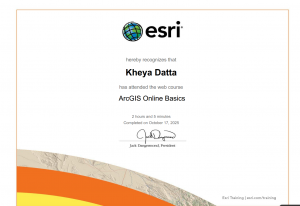Datta – Week 5
3D is easier to navigate than 2D bc the real world is 3D (woah never wouldve guessed)
3D can be photorealistic or cartographic
Divided into surfaces (elevation), features (things on the elevation), and atmosphere
Feature layers can show different objects such as benches
Building scene layer: allows for scenes of buildings
Discipline and Category exist but I don’t entirely understand what they are
Filters allow you to view only specific parts of the scene
Integrated Mesh layers use drone data to make a mesh of the scene
Pointed maps are like those LIDAR scans (which my only experience with LIDAR is with horror games so. bleh.)
Voxel scenes add temperature into the mix of 3D scenes
For city planning ArcGIS CityEngine is used to build cities and has been used in movies
3D scenes can be used in VR and AR
3D GIS can be used in indoor planning or in urban planning
Application: i imagine it’s more efficient to model a city in ArcGIS than in blender, so you could make a city, or if you aren’t going to do that, a building or a room
